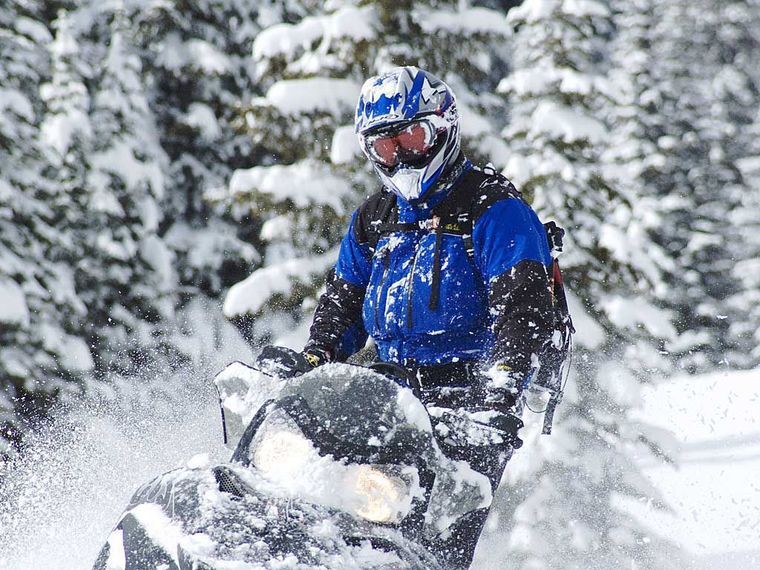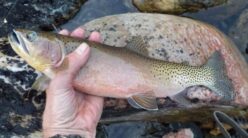The number of Utah snowmobilers is declining despite the state’s rising population, according to a report issued by Utah State University.
A recent analysis conducted by the school’s Institute of Outdoor Recreation and Tourism found that there were 11,000 households reporting snowmobile ownership in February of this year, compared to 13,000 of them in 1998 — a 15 percent decrease over the last two decades.
“I wouldn’t say it’s a dramatic decline,” said Jordan Smith, director of the Institute for Outdoor Recreation and Tourism. “This is not a trend that’s unique to Utah and a lot of other states.”
A news release about the report suggests the decline in Utah snowmobilers could be because of less interest in the recreational activity than before so that when older riders quit, they’re not being replaced by younger ones.
The decline in snowmobilers comes as Utah’s population increased 77 percent over the same two-decade period, according to the Institute’s report.
But given the hard spot the snowmobiling industry has found itself in, Smith doesn’t think the sport will completely disappear.
“It’s not a sport or an activity that people come into or go out of relatively easily,” Smith said. “You make an investment in a snowmobile, a trailer, a vehicle that can haul the trailer and snowmobile — it’s a considerable investment. Once they get involved, they tend to stay involved, so I don’t think it’s going to go away.”
The report says Cache County snowmobilers spent $2.8 million on expenses related to snowmobiling trips, which can average more than $200 for a day trip or over $500 overnight.
What worries Smith is new people not entering snowmobiling.
“It’s a slow acquisition of new users,” he said.
It’s not all bad news when it comes to the Beehive State’s snowmobiling industry. The report sheds light on strong economic statistics.
In 2016, snowmobiling accounted for over 1,300 jobs and contributed $138.2 million in local industry sales and $88.4 million in value added to Utah’s economy.
“The activity has made a significant contribution to the state’s economy — that is one thing that has remained consistent,” Smith said.
Snowmobiling has brought in $7.6 million for Cache County and $225,000 for Rich County, according to the report.
Currently there are 1,616 snowmobiles, or 885 households that own at least one registered snowmobile in Cache County, according to the report. Meanwhile, Rich County has 134 registered snowmobiles, or 34 households with at least one registered snowmobile.
The Institute’s report was prepared for the Utah Snowmobilers Association, a nonprofit. Cal Taylor, president of the Utah Snowmobilers Association, said USA hired the USU Institute to develop a report on the economic impact on snowmobiling.
Taylor said he’d like to see more people snowmobiling — and there is hope.
“We’re seeing a little bit of a return of (snowmobiling),” he said. “I think in the next year or two we’ll see an increase in family riders as they create more entry-level sleds that give them an opportunity to be out.”
Melissa Andersen, office manager at Beaver Creek Lodge, said it has purchased more snowmobiles for people to rent over the last several years.
She says rentals range in the size of the snowmobile and cost to use them for a day can go for a few hundred dollars.
Andersen tends to see a young demographic, including USU students, asking to rent snowmobiles. Though she noted renting a snowmobile is cheaper than buying and maintaining one.
Kelly Leishman, a Cache Valley resident and former president of the Top of Utah Snowmobile Association, has been snowmobiling since 1996.
He thinks one of the reasons there’s been a drop in snowmobilers is that the activity costs more as the machines’ performance reaches higher standards. Leishman estimated snowmobiles in 1996 costs just under $6,000, and today they’re about $13,000.
He also said snowmobiling doesn’t lend itself to a long season for activity, and lack of snow during some winters can only compound the issue.
“If you do have a poor season, like we’re starting out today, and you’ve invested $13,000, and maybe you only get a three-month window, sometimes that discourages people,” Leishman said. “They sell them and try a different sport.”
Leishman would like it if more families took up snowmobiling, but he understands the expense involved. He did say he’s heard off-highway vehicle sales are up and maybe families prefer that.
Leishman noted that unlike what the USU report suggests about older snowmobile riders not being replaced by younger ones, he has passed the passion on to his sons, and his sons have passed the sport on to his grandsons.
“I think the key is, almost every kid would like to be a snowmobiler if they had the opportunity,” he said. “There’s an exhilaration of your skill level, and as you get a better skill level, your love for the sport deepens, and you get more aggressive. It’s a very addicting sport.”



